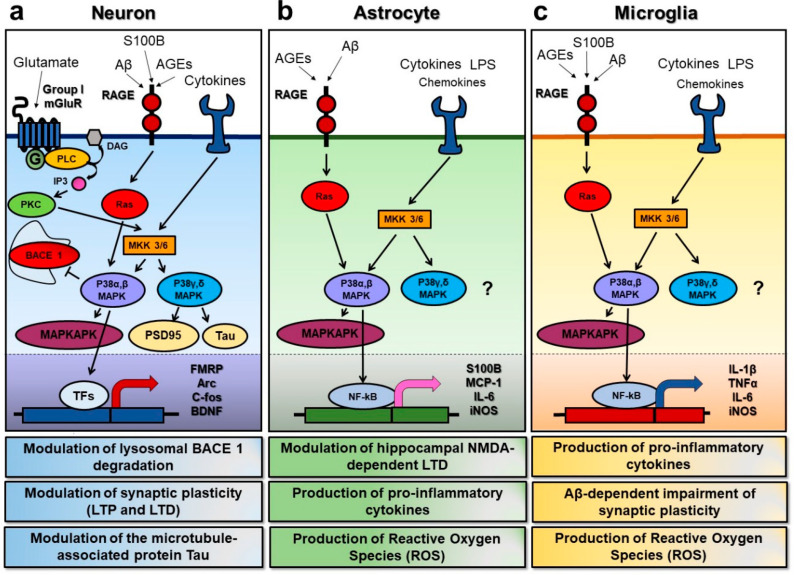Figure 1.
Overview of the p38 mitogen activated protein kinase (MAPK) signal transduction pathways in neurons, astrocytes, and microglia. p38 MAPK can be activated in response to various extracellular stimuli, such as glutamate, advanced glycation endproducts (AGEs), cytokines, and chemokines, leading to cell type-specific downstream effects. (a) In neuronal cells, the activation of the metabotropic glutamate receptors of group I (group I mGluRs) can turn on phospholipase C (PLC) and promote the phosphorylation of MAP kinase kinase 3/6 (MKK 3/6), with the subsequent activation of the p38 MAPKs. The α and β isoforms of p38 MAPK have been shown to inhibit beta-secretase 1 degradation, to promote the activation of MAP kinase activated protein kinase (MAPKAKP), and to act on specific transcription factors (TFs) to induce changes in the expression of the key proteins involved in synaptic plasticity, such as the fragile X mental retardation protein (FMRP), the activity-regulated cytoskeleton-associated protein (Arc), the c-fos protein, and the brain-derived neurotrophic factor (BDNF). On the other hand, the γ and δ isoforms seem to have a role in the modulation of synaptic proteins, such as postsynaptic density protein 95 (PSD95) and the microtubule-associated protein Tau. Furthermore, AGEs binding to the receptor for advanced glycation endproducts (RAGE) can turn on the Ras protein, and predominantly lead to the activation of p38 α and β isoforms, while cytokines and chemokines can trigger p38 MAPK by acting through their specific receptors and via MKKs. (b) In astrocytes, AGEs and pro-inflammatory molecules such as lipopolysaccharide (LPS) can lead to p38 MAPK activation as well. Moreover, p38 activation in this specific cell type has been demonstrated to modulate hippocampal n-methyl-d-aspartate (NMDA)-dependent long-term depression (LTD), to induce the production of the S100 calcium binding protein (S100B), of pro-inflammatory molecules such as the monocyte chemoattractant proten-1 (MCP-1) and interleukin-6, and to increase the production of reactive oxygen species (ROS) via the expression of inducible nitric oxide synthase (iNOS). (c) In microglia, the signaling pathways upstream of p38 MAPK activation are very similar to those found in astrocytes. However, in addition, they lead to the production of pro-inflammatory cytokines such as interleukin-1β, the tumor necrosis factor α, and IL-6, and to increase ROS production, microglial activation of the p38 α isoform has been demonstrated to play a key role in the Aβ-dependent synaptic dysfunction.

